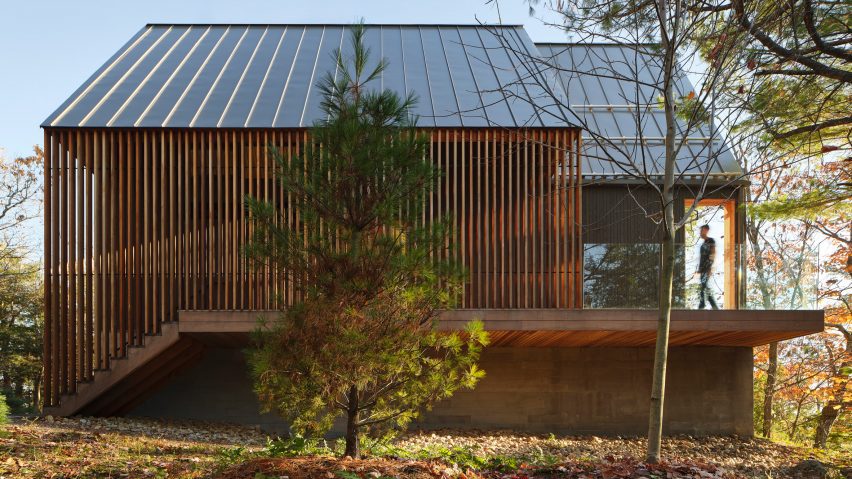Canadian studio Dubbeldam Architecture + Design has wrapped a lakeside cabin in cedar and topped it with a split gable roof that reinterprets a traditional A-frame cabin in Ontario.
Known as Bunkie on the Hill, the 1,000-square foot (93-square metre) cabin is tucked into the treeline overlooking a lake in Muskoka, Ontario.
Dubbeldam Architecture + Design, which is based in Toronto, completed the quiet retreat in the fall of 2022 as a place of respite – uphill from a set of multi-generational family cottages – an opportunity to reconnect with nature.
The rectangular cabin is characterized by a shifted roof that splits one gable into two in a "contemporary interpretation of the traditional A-frame shape."
"Reminiscent of the overlapping layers of shale rock in the surrounding landscape, the split roof design features two intersecting gables that create opportunities for window openings where the roof volumes separate," the studio said.
"These geometric windows allow for curated views of the treetops on one side and lake below on the other and invite natural light to flood the interior of the cabin, reflecting off the sharp roof angles and creating dramatic lines and shadows."
The split roof generates distinct elevations on each side of the cabin with opaque facades facing the forest – punctuated by sharp windows in sleek frames – on the north and east sides.
The south facade is defined by a tall glazed wall that continues up into the sharp roofline and opens the interior to views of the lake.
Set on a board-formed concrete base, the greyed wood siding and standing-seam metal roof are a cool exterior contrast to the warm-toned cedar entryway, where a thick screen and heavy soffit frame a tunnel-like porch on the west side of the cabin.
Visitors ascend a small staircase to the side porch to reach an entryway located halfway down the facade.
"The cedar slats are animated by the ever-changing west light that filters through its openings, producing a dynamic interplay of light and shadows that enhance the richness of the material and creating an engaging experience for visitors," the studio said.
The entrance leads directly into the kitchen, which is open to the living room via a dining peninsula. Tucked on the north side of the compact rectangular cabin is the primary bedroom and bathroom with a large window that "offers immersive views of the forest".
In the living area, a smooth maple plywood staircase leads up to a loft with a built-in desk, extra sleeping space and a hilltop perspective of the lake.
The interior's natural materials were selected to complement the rustic landscape, but differing wood species differentiate various planes. Oak flooring transitions to white wallboard, giving way to Western red cedar slats that rise up the steep ceiling of the vaulted roof.
The wood tones are contrasted by dark charcoal window frames, grey stone counters, a black metal wood stove, and soft grey furnishings.
"The Bunkie's interior is functional despite its compact size," the studio said. "Small nooks throughout contain storage shelves or built-in benches."
Specific materials and construction methods – like thickened walls, triple-glazed windows and flitch beams that eliminate thermal bridges – help insulate the house in the cold climate.
A minimal heating system sits in the crawl space, which was created by setting the house on a natural rock contour, eliminating the need for blasting and "allowing the structure to sit lightly on the landscape."
The FSC-rated wood products will patina over time and help the cabin blend into its setting.
Other cabins recently completed in Canada include a lifted Corten cube in Nova Scotia by Omar Gandhi Architects and a slanted beachside retreat in British Columbia by Laura Killam Architecture.
The photography is by Riley Snelling.
Project credits:
General Contractor: HLD Corporation
Structural Engineer: Blackwell Structural Engineers
Design team: Heather Dubbeldam, Scott Sampson, Krystal Kramer

